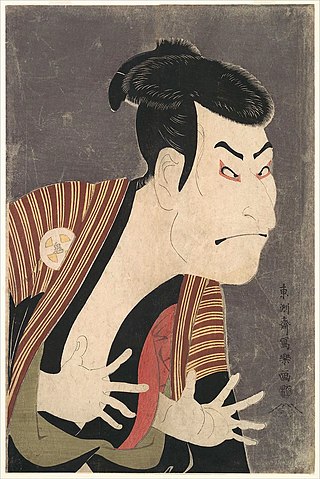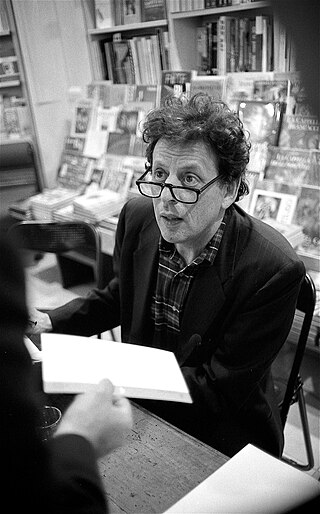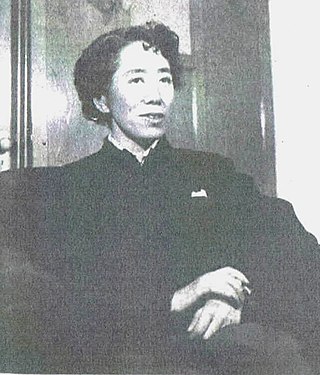
Kabuki is a classical form of Japanese theatre, mixing dramatic performance with traditional dance. Kabuki theatre is known for its heavily stylised performances, its glamorous, highly decorated costumes, and for the elaborate kumadori make-up worn by some of its performers.

The performing arts are arts such as music, dance, and drama which are performed for an audience. They are different from the visual arts, which involve the use of paint, canvas or various materials to create physical or static art objects. Performing arts include a range of disciplines which are performed in front of a live audience, including theatre, music, and dance.

The following outline is provided as an overview of and topical guide to theatre:

Tōshūsai Sharaku was a Japanese ukiyo-e print designer, known for his portraits of kabuki actors. Neither his true name nor the dates of his birth or death are known. His active career as a woodblock artist spanned ten months; his prolific work met disapproval and his output came to an end as suddenly and mysteriously as it had begun. His work has come to be considered some of the greatest in the ukiyo-e genre.

An intermission, also known as an interval in British and Indian English, is a recess between parts of a performance or production, such as for a theatrical play, opera, concert, or film screening. It should not be confused with an entr'acte, which, in the 18th century, was a sung, danced, spoken, or musical performance that occurs between any two acts, that is unrelated to the main performance, and that thus in the world of opera and musical theater became an orchestral performance that spans an intermission and leads, without a break, into the next act.

Noh is a major form of classical Japanese dance-drama that has been performed since the 14th century. Developed by Kan'ami and his son Zeami, it is the oldest major theater art that is still regularly performed today. Although the terms Noh and nōgaku are sometimes used interchangeably, nōgaku encompasses both Noh and kyōgen. Traditionally, a full nōgaku program included several Noh plays with comedic kyōgen plays in between; an abbreviated program of two Noh plays with one kyōgen piece has become common today. Optionally, the ritual performance Okina may be presented in the very beginning of nōgaku presentation.

Bunraku is a form of traditional Japanese puppet theatre, founded in Osaka in the beginning of the 17th century, which is still performed in the modern day. Three kinds of performers take part in a bunraku performance: the Ningyōtsukai or Ningyōzukai (puppeteers), the tayū (chanters), and shamisen musicians. Occasionally other instruments such as taiko drums will be used. The combination of chanting and shamisen playing is called jōruri and the Japanese word for puppet is ningyō. It is used in many plays.

Kyōgen is a form of traditional Japanese comic theater. It developed alongside Noh, was performed along with Noh as an intermission of sorts between Noh acts on the same stage, and retains close links to Noh in the modern day; therefore, it is sometimes designated Noh-kyōgen. Its contents are nevertheless not at all similar to the formal, symbolic, and solemn Noh theater; kyōgen is a comic form, and its primary goal is to make its audience laugh.

A theater, or playhouse, is a structure where theatrical works, performing arts, and musical concerts are presented. The theater building serves to define the performance and audience spaces. The facility usually is organized to provide support areas for performers, the technical crew and the audience members, as well as the stage where the performance takes place.

Traditional Japanese theatre is among the oldest theatre traditions in the world. Traditional theatre includes Noh, a spiritual drama, and its comic accompaniment kyōgen; kabuki, a dance and music theatrical tradition; bunraku, puppetry; and yose, a spoken drama.

the CIVIL warS: a tree is best measured when it is down is an opera created in the early 1980s by director Robert Wilson to music by Philip Glass, David Byrne, Gavin Bryars and others. The vast five-act work has never been performed whole.

Tetsuji Takechi was a Japanese theatrical and film director, critic, and author. First coming to prominence for his theatrical criticism, in the 1940s and 1950s he produced influential and popular experimental kabuki plays. Beginning in the mid-1950s, he continued his innovative theatrical work in noh, kyōgen and modern theater. In late 1956 and early 1957 he hosted a popular TV program, The Tetsuji Takechi Hour, which featured his reinterpretations of Japanese stage classics.

The Konpira Grand Theatre, also known as the Kanamaru-za (金丸座) is a restored Kabuki theatre in Kotohira, Kagawa, on the island of Shikoku, Japan. It was originally constructed in 1835, and is the oldest kabuki theatre in Japan. Kabuki plays are performed for one month each year, usually in April.

Kunio Kishida was a Japanese playwright, dramatist, novelist, lecturer, acting coach, theatre critic, translator, and proponent of Shingeki. Kishida spearheaded the modernization of Japanese dramaturgy and transformed Japanese theatre acting. He was a staunch advocate for the theatre to operate as a dual artistic and literary space.

Minami-za is the primary kabuki theatre in Kyoto, Japan. It was founded in 1610 as Shijō Minami-za. The current building, with a 1,086 seat capacity, was built in 1929.
Shingeki was a leading form of theatre in Japan that was based on modern realism. Born in the early years of the 20th century, it sought to be similar to modern Western theatre, putting on the works of the ancient Greek classics, William Shakespeare, Molière, Henrik Ibsen, Anton Chekov, Tennessee Williams, and so forth. As it appropriated Western realism, it also introduced women back onto the Japanese stage.

A hayashi (囃子) is a group of performers who provide musical accompaniment for Japanese Nō or kabuki theatre, yose performances of rakugo, or a festival.

Akimoto Matsuyo was a leading playwright of postwar Japan, most respected as a realist Japanese playwright. Akimoto was known for her shingeki plays, but also wrote some classical bunraku (puppet) and kabuki dramas, and she later became a scriptwriter for both radio and television shows. Along with Akimoto's childhood, World War II played a significant role in her career. As a realist playwright, she used her work to make political statements in order to warn the greater Japanese community that the government was trying to continue their pre-war imperial system of capitalism, militarism, and patriarchy.
Carol Fischer Sorgenfrei is a scholar, translator, editor, and playwright who assumes the title of "founding mother" of Asian theater studies for her contributions to the study of cross-cultural performance and her expertise in Asian theatre. She has published extensively on Asian cultural practices and has written plays incorporating elements of traditional Japanese drama. Currently Professor Emeritus at UCLA, Sorgenfrei continues her creative work as a playwright.

Shosagoto (所作事) or furigoto (振事), also known as dance or dance-drama, is a type of kabuki play based on dance. It is one of the three genres of kabuki, together with jidaimono and sewamono.




















